An odd twist of corrosion & transmission
February 2nd, 2023
Jury awards Fayette County dairy $4.75M in stray voltage lawsuit
Here’s the part that jumped up and hollered:
I’m familiar with the notion that transmission lines over pipelines can/do corrode the pipeline, so this use of “an anti-corrosion system that sends electricity into the ground to protect the pipeline” seems counter intuitive. So digging just a bit, the term “cathodic protection,” which does ring a bell.
Cool Science: Using Electricity to Fight Corrosion
And that article says:
To fight corrosion, we employ a technique called cathodic protection, which literally uses electrical currents to prevent rust.
With cathodic protection, a flow of electrical current is applied from an external source – a rectifier – through the ground and onto the steel pipe. The protective current changes the environment around the steel, stopping the corrosion reaction.
And “cathodic protection” is not a new concept either.
The intersection of these two concepts is what’s got me stumped. Adding this to the list of things to look into when I’m in a warm and isolated cabin up north!
PPSA Annual Hrg – TOMORROW!
December 19th, 2021

And AGAIN! It’s the Power Plant Siting Act Annual Hearing! You can attend in person, MASKED, or via webex or phone. Primary documents are posted below.
December 20, 2021 @ 9:30
PUC Large Meeting Room
121 – 7th Place East – 3rd Floor
St. Paul, MN
Comments? BE SURE TO NOTE DOCKET NUMBER FOR COMMENTS:
PUC Docket E999/PR-21-18 & OAH Docket 65-2500-37832
Written comments will be accepted through January 10, 2022, by 4:30 p.m.

Note notice only to those “who have requested notice” above? Nope, notice should be to all who are on service and project lists for projects active in the calendar year. Thankfully EERA does give notice to a lot more than just those “who have requested notice” (see “Notice & Service Lists” link posted above).
From the EQB Monitor:

Here are the projects EERA’s Summary says were approved — note that for wind it does NOT list applicable parts of 216E, such as Minn. Stat. 216E.03, Subd. 7!

Meanwhile, the update of rules for PPSA siting, Minn. R. ch. 7850, is stalled out again, WITHDRAWN by the PUC last Thursday, supposedly based on many comments made over the last few weeks by a bunch of people and orgs who were utterly absent through the NINE YEARS of this rulemaking proceeding. My grits are FRIED! The PUC Agenda Item starts at the very end of the meeting, and note the bogus statements about the “why” of this rulemaking. Let’s be clear here — it’s due to the 2005 legislative changes, SIXTEEN YEARS AGO. See PUC Docket R-12-1246. Good grief… Discussion starts at 2:48:28:
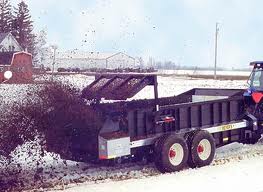
RULES! PUC’s 7849 & 7850
October 12th, 2021

Can it be?!?! The rulemaking based on the 2005 statutory changes was published in the state register today. TODAY… 2005… SIXTEEN YEARS, and NINE YEARS since this 12-1246 docket was opened. Comments are due by November 17, more on that below.
The Public Utilities Commission did one hell of a job delaying until BILLIONS of CapX 2020, a/k/a CapX 2050 and Grid North Partners and MTEP MVP projects were rammed through. Public interest anyone? Naaaaaaah…
Here it is — First the Notice (60 page service list!), then Statement of Need and Reasonableness (SONAR) and then the proposed rules (yeah, 120+ pages):
Comments are due November 17th:

Here’s the catch — they are planning on putting these through without a hearing before an Administrative Law Judge, UNLESS there are at least 25 requests for a hearing — I think that can be arranged. Here are the details, note that they must be “valid” requests, which means explain in short what you want differently in the rules:

ONWARD! SIXTEEN YEARS… UNREAL!
Transmission inefficiency, pipeline pumping stations, now this?
June 29th, 2017
For years, for decades, I’ve been going on and on about the inefficiency of transmission, the electric system, and line losses ad nauseum. Y’all know that, if you’ve been paying attention. And here we are, back to discussing inefficiency in the electric system.
The SW MN 345 kV Transmission Lines (PUC Docket 01-1958) turned on line losses. After that close call, line losses were calculated and considered on a very different model, framing it as a percentage of THE ENTIRE EASTERN INTERCONNECT. So what’s a little loss of 0.1%, who cares… well, as a part of THE ENTIRE EASTERN INTERCONNECT, it adds up fast. Let me make this perfectly clear, transmission line loss is substantial. It’s particularly substantial when you’re talking about using transmission to ship lower capacity energy, like wind and solar. If you have long, hundreds of miles long, transmission lines, there’s not much, if any, of that energy that would find its way to its destination.
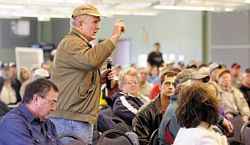
There’s a “Stakeholder Meeting” coming up:
Register here
Those words, “Stakeholder Meeting” get my attention, because just who is a stakeholder, who decides. I don’t recall getting this email, but thankfully a client who is regarded as a “Stakeholder” did, so I’ve signed up and will spend the time to show up and raise a few points.
Upcoming Stakeholder Meeting: Opportunities and Barriers to Utility Infrastructure Efficiency
Friday, July 28th from 8:30 a.m. – 12:30 p.m.
Wilder Center – 451 Lexington Pkwy. N, Saint Paul, MN 55104
Register for this free public meeting
Meeting Details
An estimated 12-15% of the nation’s electricity production is consumed by generation auxiliary loads, transmission and distribution losses, and substation consumption. As such, there is significant potential to increase utility infrastructure efficiency by decreasing conversion losses, improving plant operations, and mitigating transmission and distribution losses throughout Minnesota’s electric grid.
The Minnesota Department of Commerce invites you to participate in a stakeholder meeting to explore opportunities and barriers to utility infrastructure efficiency projects, and to begin developing a framework to improve the overall generation, transmission, and distribution efficiency of Minnesota’s electric system.
Meeting attendees will hear from national and local experts and gain insight into how existing, new, and on-the-horizon utility infrastructure technologies can increase system efficiency, including:
- A presentation by the Electric Power Research Institute, highlighting innovative utility infrastructure efficiency projects and approaches from around the country.
- A presentation from Minnkota Power Cooperative, discussing lessons learned from implementing infrastructure efficiency projects in Minnesota.
- Information about next steps in the stakeholder engagement process, including a deeper-dive examination of supply-side efficiency policy issues.
Register here
U of M Humphrey “report” on CapX 2020
April 28th, 2016

It’s out, the report from U of M Humphrey School of Public Affairs about CapX 2020, headlining it as a “Model for addressing climate change.“
Transmission Planning and CapX 2020: Building Trust to Build Regional Transmission Systems
Oh, please, this is all about coal, and you know it. This is all about enabling marketing of electricity. In fact, Xcel’s Tim Carlsbad testified most honestly that CapX 2020 was not for wind! That’s because electrical energy isn’t ID’d by generation source, as Jimbo Alders also testified, and under FERC, discrimination in generation sources is not allowed, transmission must serve whatever is there. And the report early on, p. 4, notes:
Both North and South Dakota have strong wind resources and North Dakota also has low-BTU lignite
coal resources that it wants to continue to use. New high-voltage transmission lines are needed to
support the Dakotas’ ability to export electricity to neighboring states.See also: ICF-Independent Assessment MISO Benefits
Anyway, here it is, and it’s much like Phyllis Reha’s puff piece promoting CapX 2020 years ago while she was on the Public Utilities Commission, that this is the model other states should use:
MN PUC Commissioner Reha’s Feb 15 2006 presentation promoting CapX 2020
So put on your waders and reading glasses and have at it.
Here’s the word on the 2005 Transmission Omnibus Bill from Hell – Chapter 97 – Revisor of Statutes that gave Xcel and Co. just what they wanted, transmission as a revenue stream:

And note how opposition is addressed, countered by an organization that received how much to promote transmission. This is SO condescending:
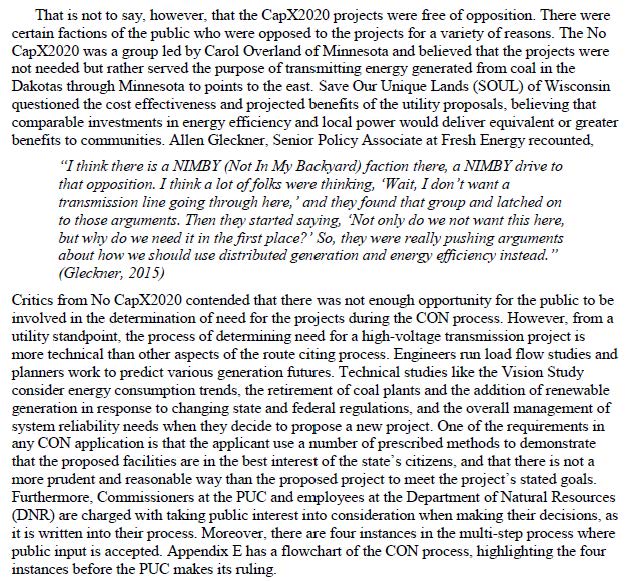
… and opposition discounted because it’s so technical, what with load flow studies, energy consumption trends, how could we possibly understand? We couldn’t possibly understand… nevermind that the decreased demand we warned of, and which demonstrated lack of need, was the reality that we were entering in 2008.
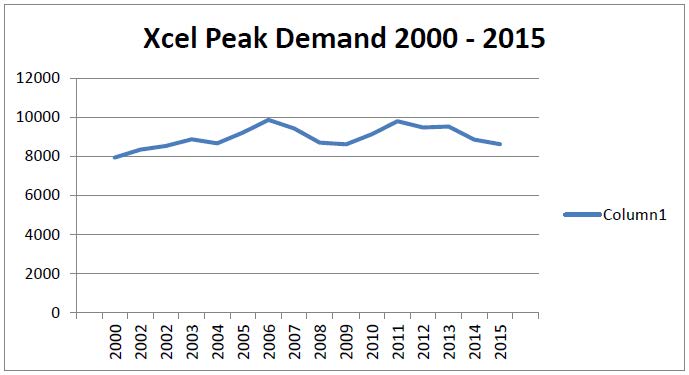
And remember Steve Rakow’s chart of demand, entered at the very end of the Certificate of Need hearing when demand was at issue??? In addition to NO identification of axis values, the trend he promoted, and which was adopted by the ALJ and Commission, has NOT happened, and instead Xcel is adjusting to the “new normal” and whining that the grid is only 55% utilized in its e21 and rate case filings. Here’s Steve Rakow’s chart:
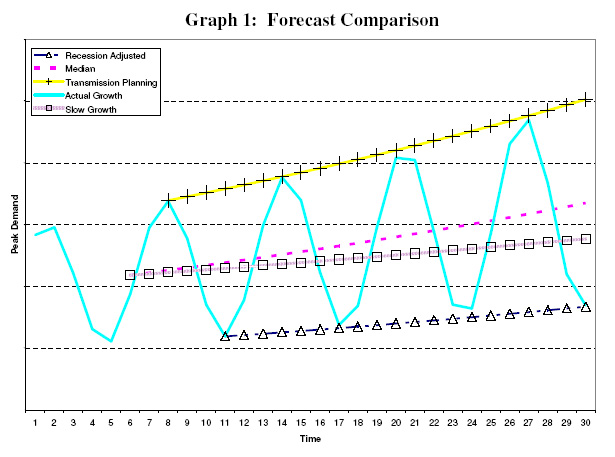
Reality peak demand trajectory was lower than Rakow’s “slow growth” line, in fact, it’s the opposite from 2007 to present. Suffice it to say:



